Disclaimer: This post may contain Amazon affiliate links. Sudachi earns a small percentage from qualifying purchases at no extra cost to you. See disclaimer for more info.
Featured Comment:
“Thank you for the recipe and video! Making them right now for my second time!”
– @BriannaSinkler_ (from YouTube)
What is Ichigo Daifuku?
Daifuku (大福) is a Japanese sweet that consists of a sweet rice cake which is stuffed with a sweet filling. The most common filling is “anko” (餡子) or “red bean paste” made from adzuki beans. It is also common to fill them with fruits or cream too.
“Ichigo” is the Japanese word for strawberry, so in the case of Ichigo Daifuku, the mochi and anko are wrapped around a whole strawberry. I have to say that the tart strawberry combined with the sweet anko and mochi creates a wonderful balance and it’s no wonder that it’s one of the most popular kinds of daifuku!
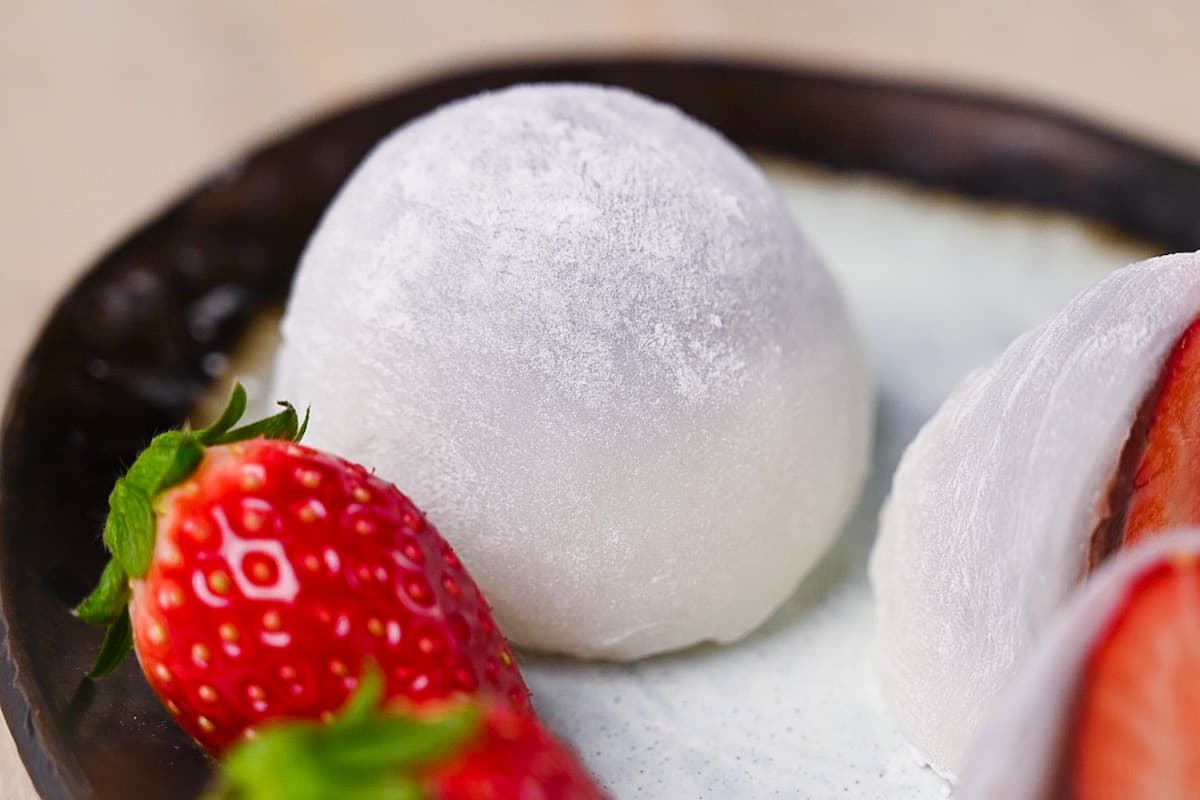
The difference between mochi and daifuku
When translated into English, Ichigo Daifuku is known as “Strawberry Mochi”. With this in mind, you might wonder why this sweet is not called “ichigo mochi,” but there is a real reason for that.
Mochi is a Japanese rice cake made from a glutinous rice called mochigome (もち米). The mochigome is steamed and pounded to form a firm and chewy rice cake known as “mochi.” Traditionally mochi would be pounded in a mortar called an “usu” (臼).
These days you can buy mochi machines and make it at home, but it’s much more common to buy it premade (you can buy cut mochi on Amazon). Once cooled the mochi becomes hard. It’s often served toasted with dipping sauce or cooked in soups, it’s known to Japanese people as a more of a savory ingredient.
On the other hand, daifuku is made with something called “gyuhi” (求肥). Gyuhi is a soft and sweet mochi-like dough made by kneading glutinous rice flour (also made with mochigome) with sugar and water over heat.
Once cooked and kneaded, it forms a stretchy rice dough that can be wrapped around various fillings. Unlike mochi, even when cooled, gyuhi maintains its soft texture due to the sugar content. This is what makes daifuku different from mochi and why gyuhi is more suitable for making sweets.
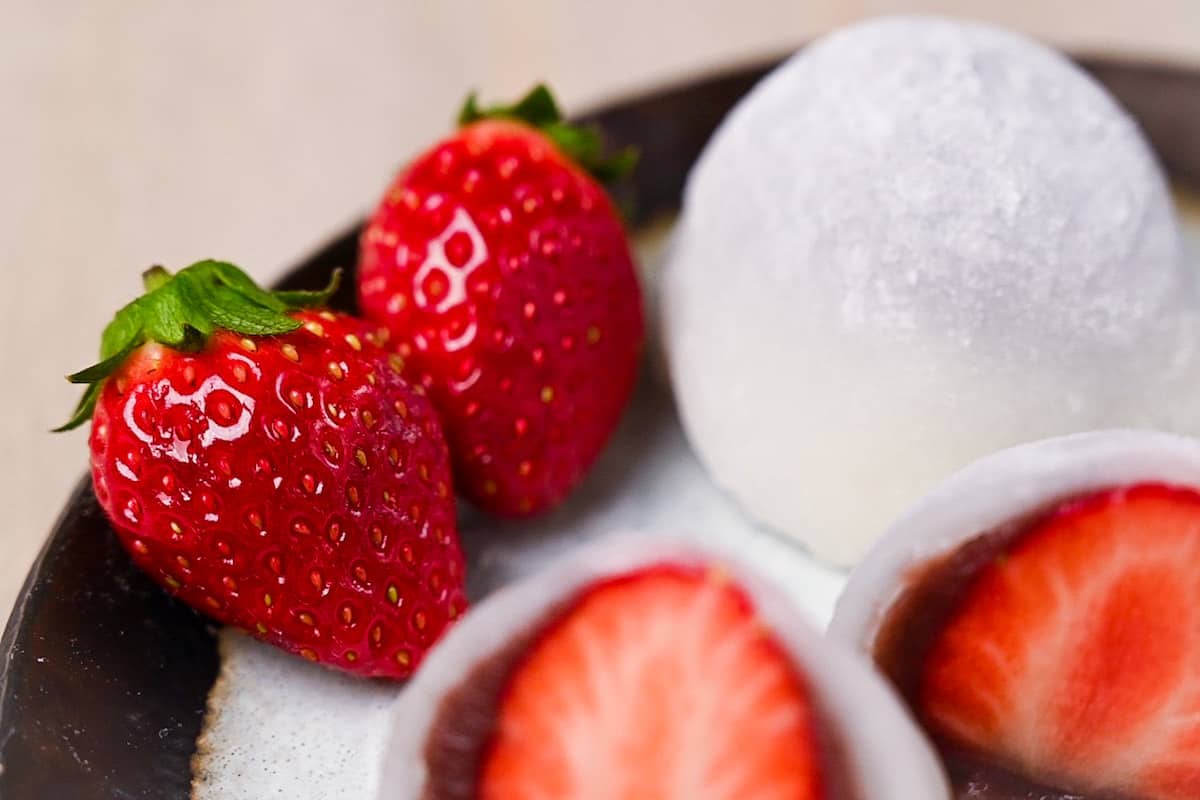
Key Ingredients & Substitution Ideas
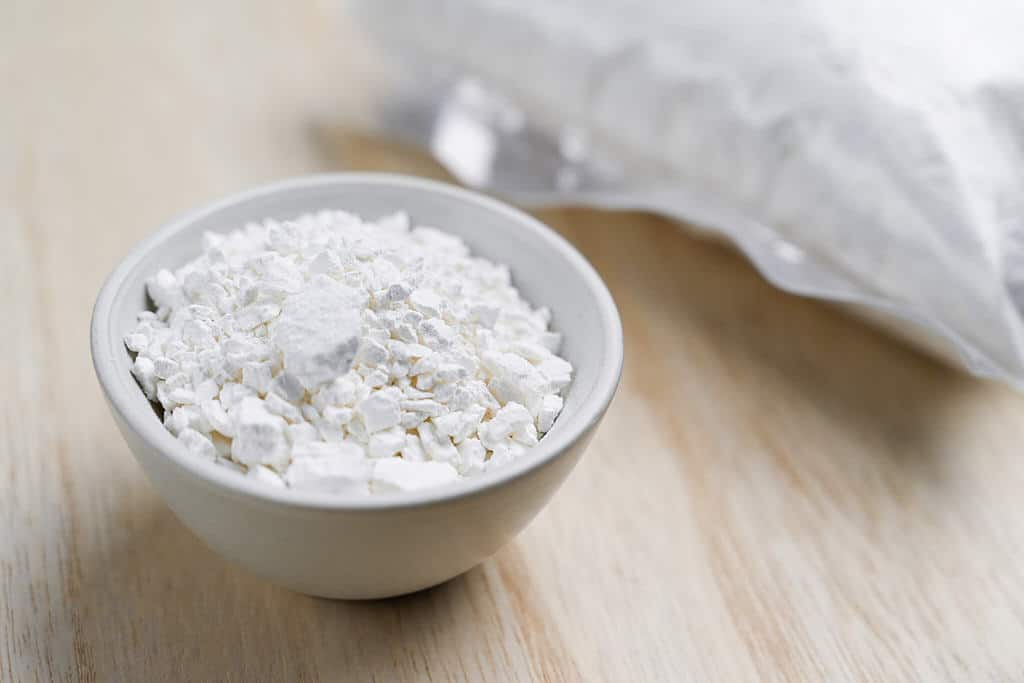
Making ichigo daifuku requires a few special ingredients. I will explain each one in more detail below.
- Glutinous rice flour: The most important ingredient for this recipe is glutinous rice flour; regular rice flour will not work. This is because glutinous rice flour is made from a special kind of sticky rice called “mochigome.” The two most common types of glutinous rice flour are mochiko (もち粉) and shiratamako (白玉粉). You can use either for this recipe, but I find shiratamako results in a softer, stretchier texture.
- White sugar: Caster sugar or granulated sugar work adds sweetness to the mochi and helps it stay soft.
- Koshian: A smooth paste made from adzuki beans. It is also common to use white bean paste (shiroan) but can be harder to find. You can buy koshian on Amazon or if you’re interested in making your own, check out my homemade koshian recipe here. Tip: Keep koshian in the refrigerator for easy shaping.
- Strawberries: Using small or medium strawberries will make it easier to wrap the daifuku.
- Potato starch (or corn starch): Will stop the gyuhi (mochi dough) from sticking to hands, surfaces and utensils.

Visual Walkthrough & Tips
Here are my step-by-step instructions for how to make Strawberry Mochi at home. For ingredient quantities and simplified instructions, scroll down for the Printable Recipe Card below.
Smooth anko (koshian in Japanese) can vary in texture depending on your brand. Some can be rolled straight from the packet with no problem, others need refrigeration and even a few are extremely soft and difficult to handle.
Please only use this step if your anko is too soft to roll!
I recommend refrigerating anko for at least an hour before use. If, after refrigerating your anko, it is still too sticky or soft to roll, you can divide it into 20g pieces (this is how much I use per daifuku) and chill it in the fridge uncovered to dry it out a little (just check it regularly to ensure it doesn’t dry out too much).
For particularly soft koshian, you can heat it in a saucepan on low heat to help evaporate some of the excess moisture. If you do this, be sure to mix continuously to prevent burning and stop once it starts to lighten in color. Spread it out on a plate and lightly cover it with plastic wrap to help it cool quickly without drying out too much.
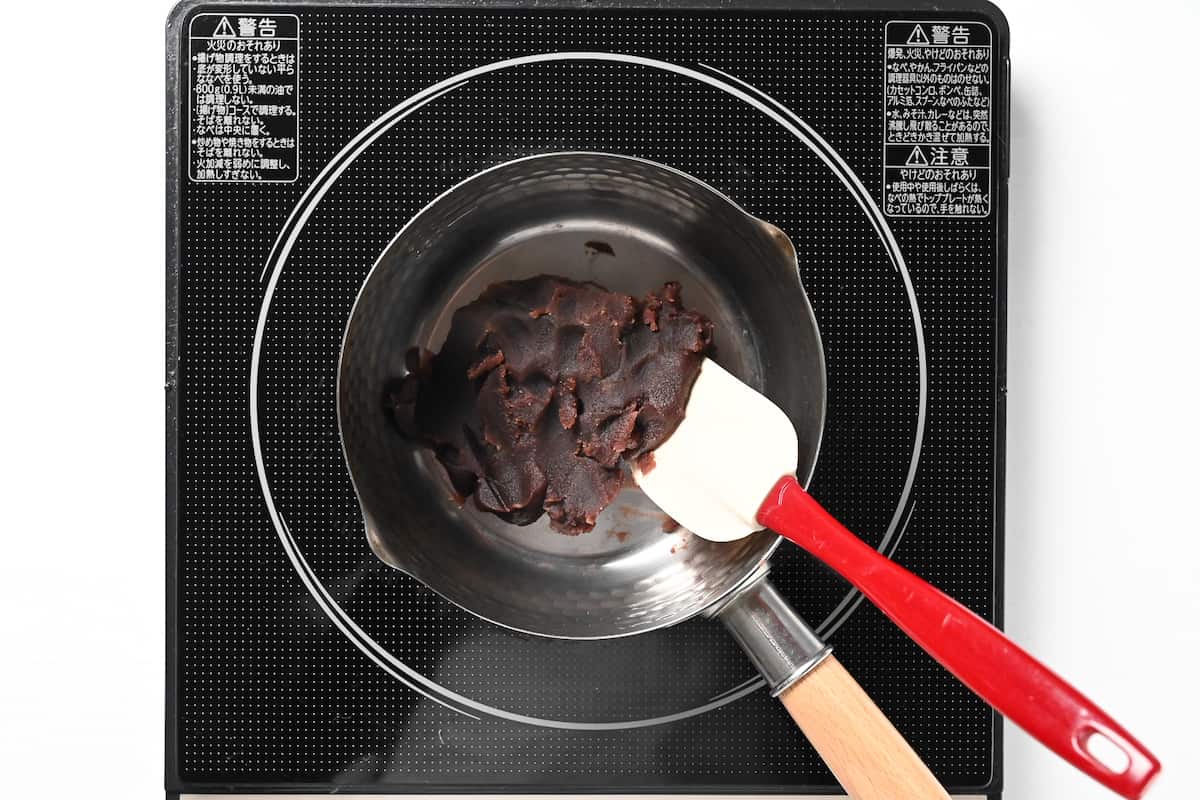
Roll the anko into 20g balls and rest in the fridge while you prepare the strawberries.
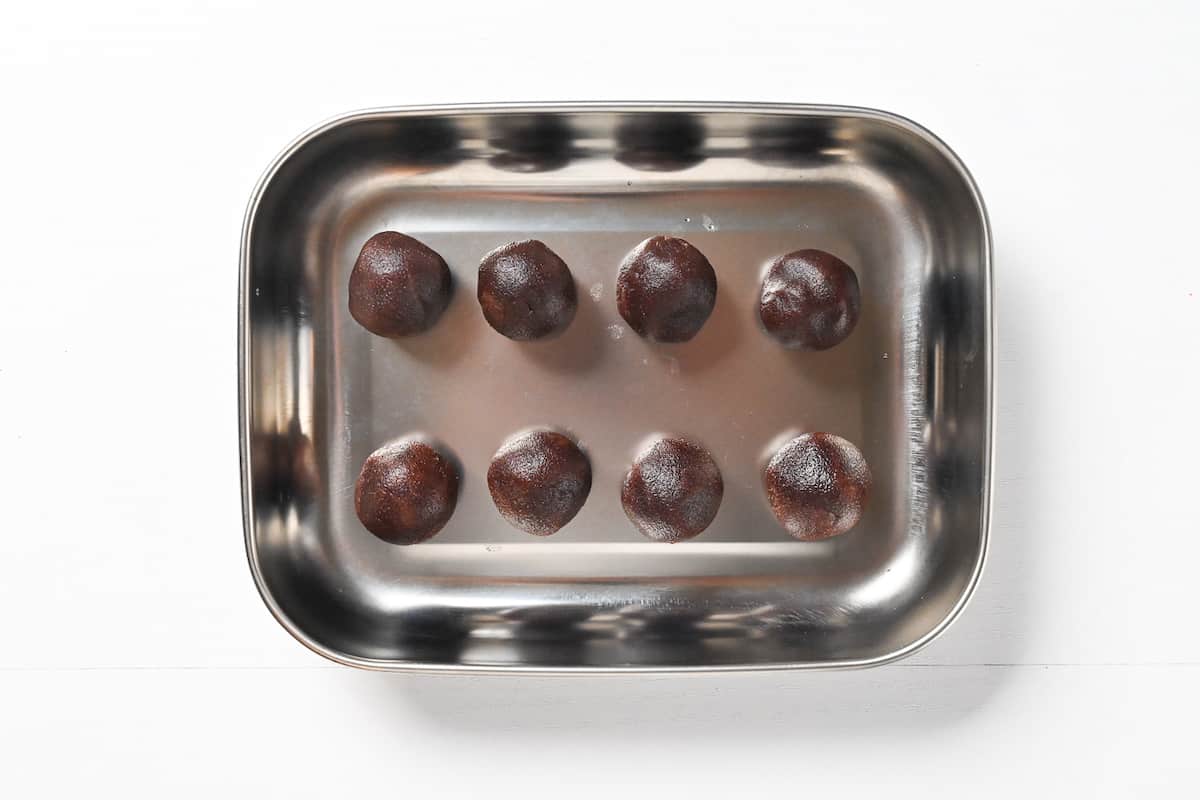
Wash the strawberries with cold water and dry them thoroughly with kitchen paper.
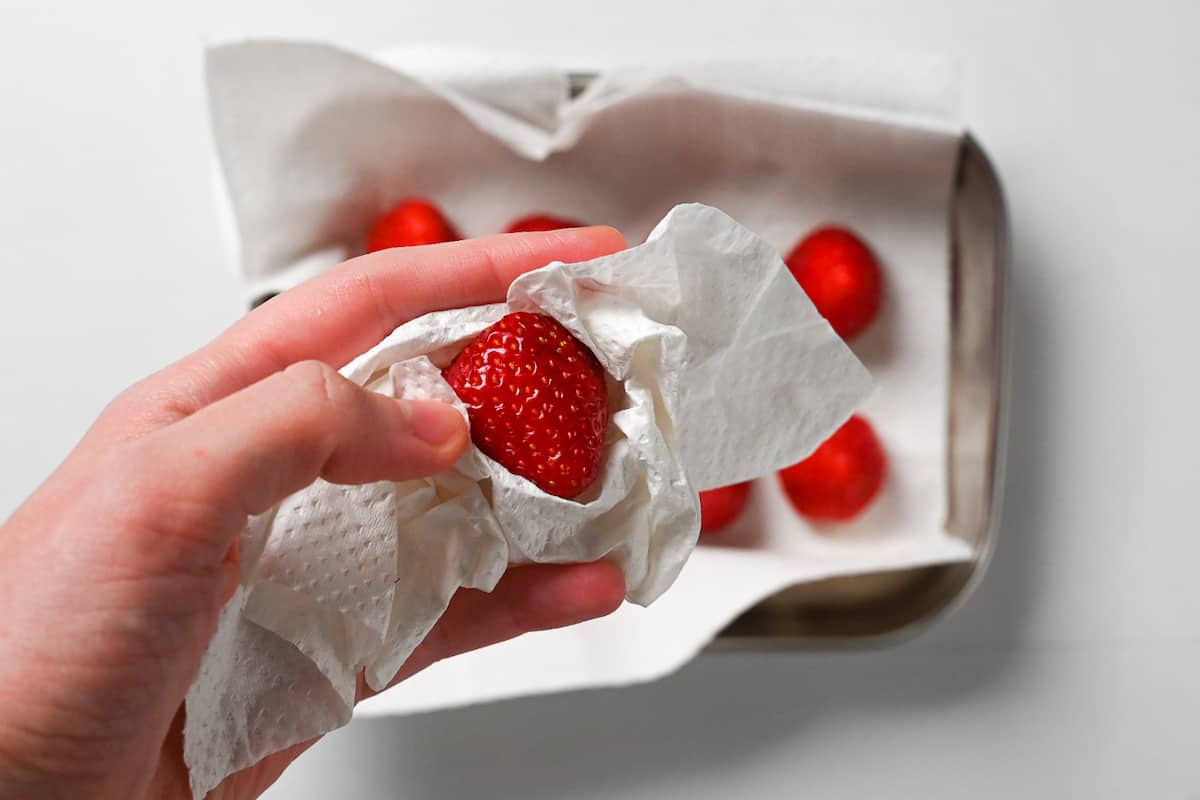
Cut off the stems and place them down with the cut part on kitchen paper to help dry them further.
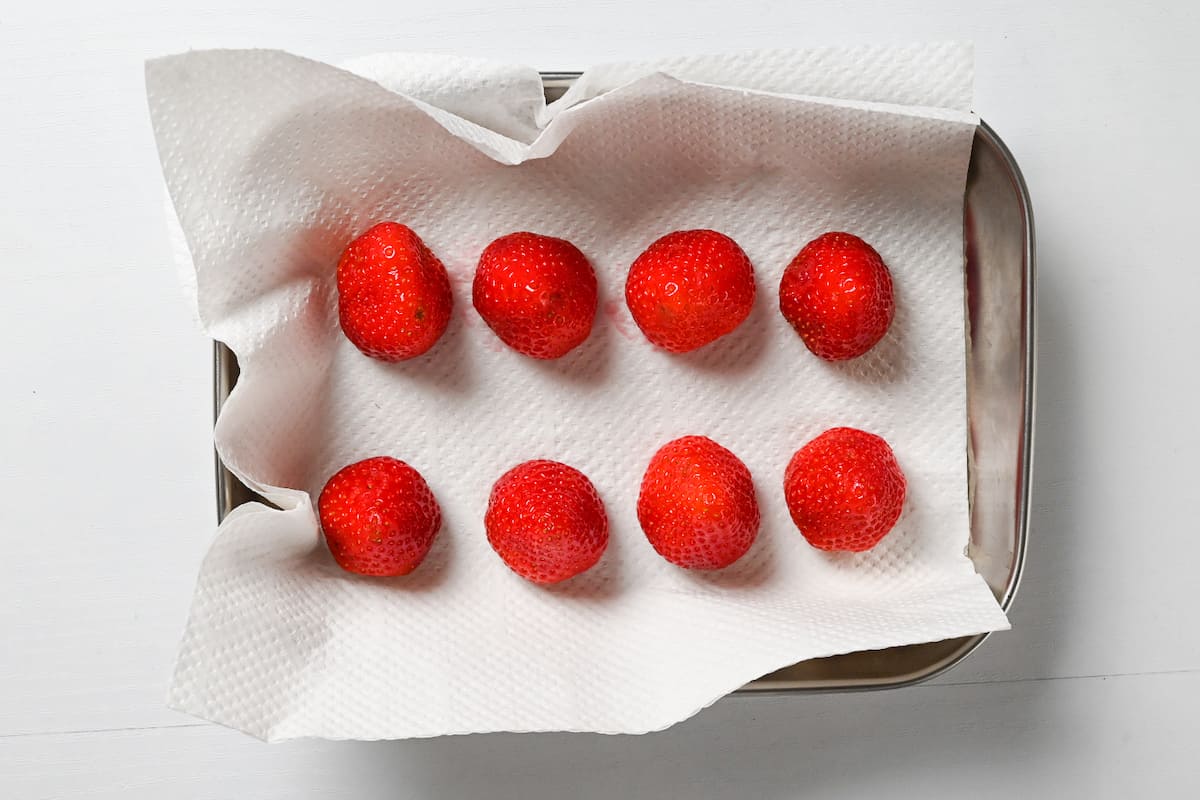
Use fresh, good-quality strawberries for the best results. Try to choose strawberries that are small/medium in size. Not only do they taste better (strawberries tend to lose their flavor as they grow bigger), but they’re also easier to wrap with anko and mochi!
Take each ball of anko and press it gently on the palm of your hand to flatten it out into a circle a little bigger than the strawberry. Don’t press too hard or it will stick to your hand.
You can make it bigger by gently pinching from the center outwards while rotating. Once it’s a good size, place the strawberry with the point facing up.
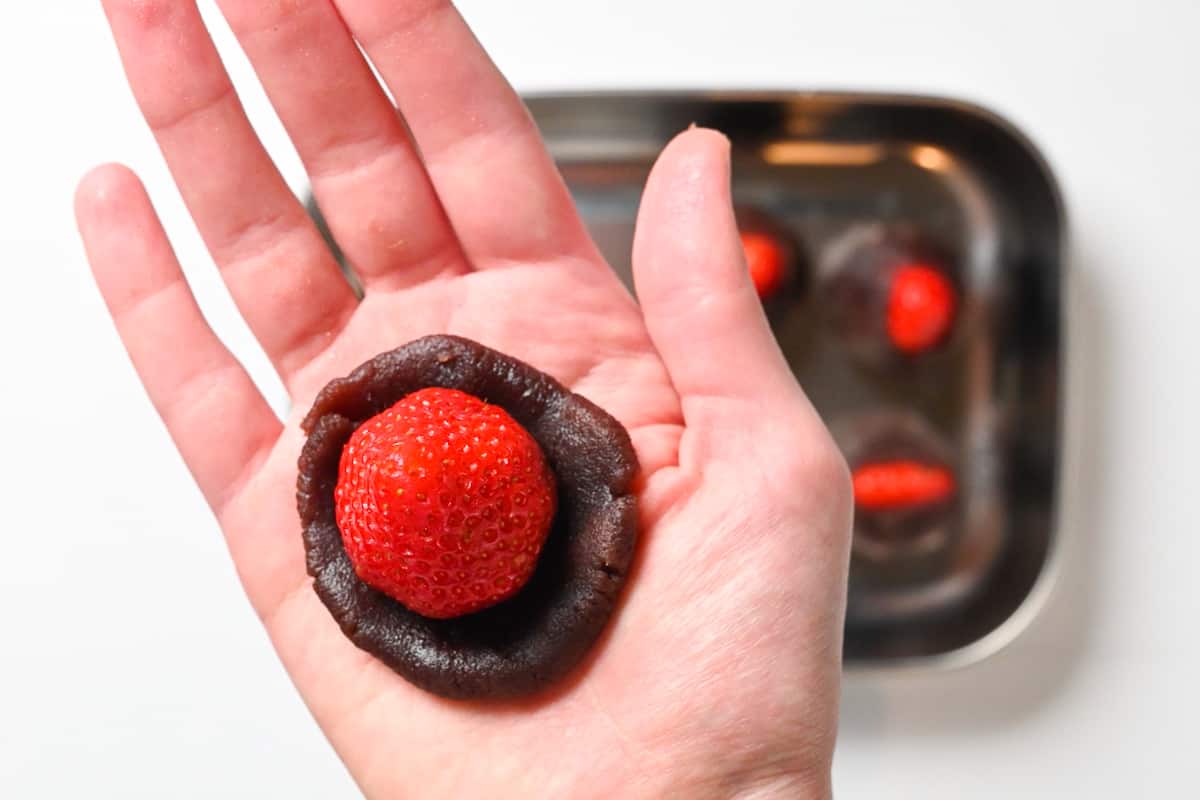
Pull the edges of the anko up and around the strawberry, leaving the top slightly exposed. This is so that you can see the position of the strawberry when wrapping it in the mochi. (The strawberry’s point should always be pointing upwards.)
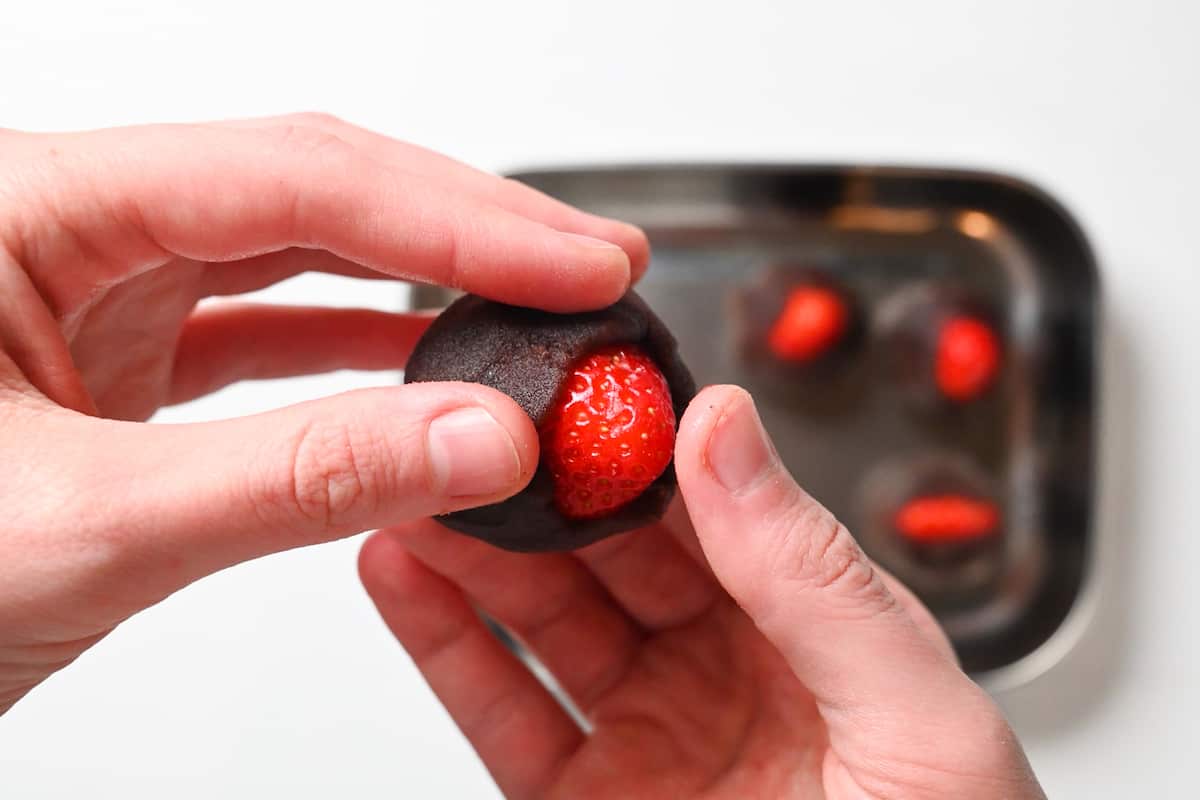
Once they’re all wrapped, cover them and store them in the fridge for later.
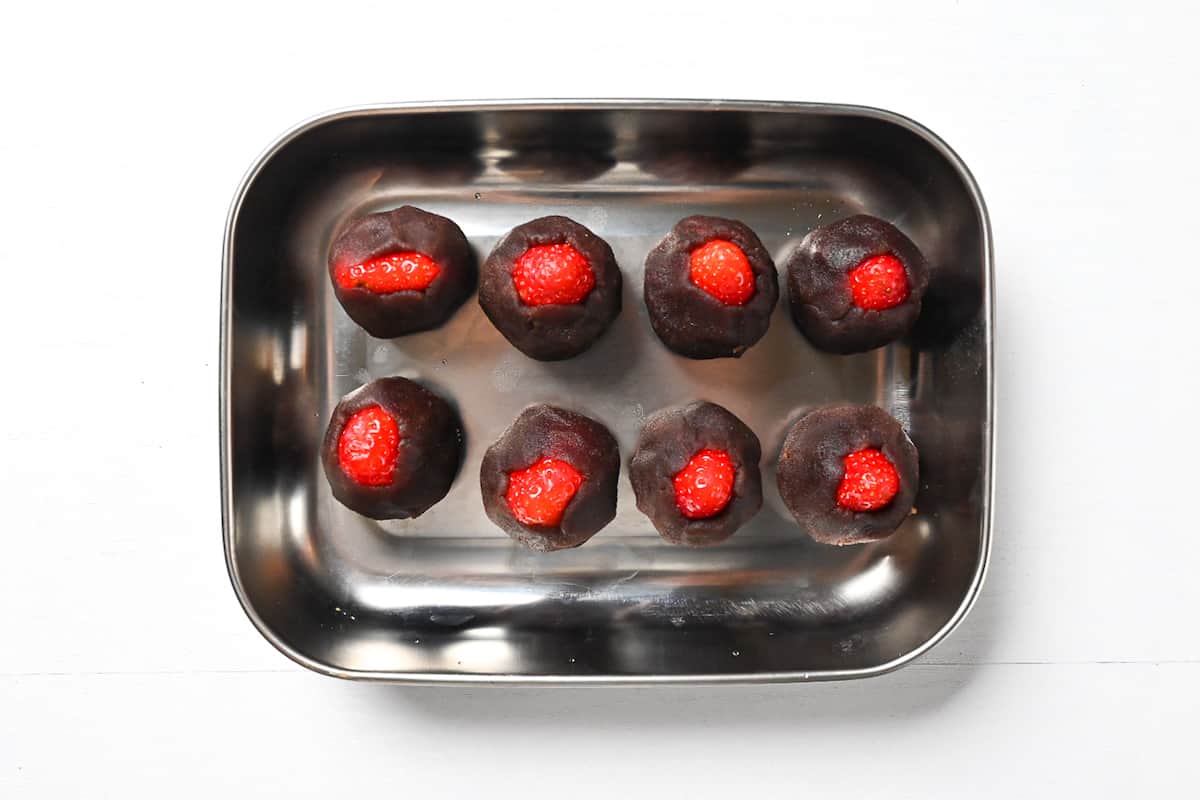
First, whisk the glutinous rice flour with sugar in a microwavable mixing bowl, mixing the dry ingredients first helps it mix more evenly.
I highly recommend using a glass bowl for this.
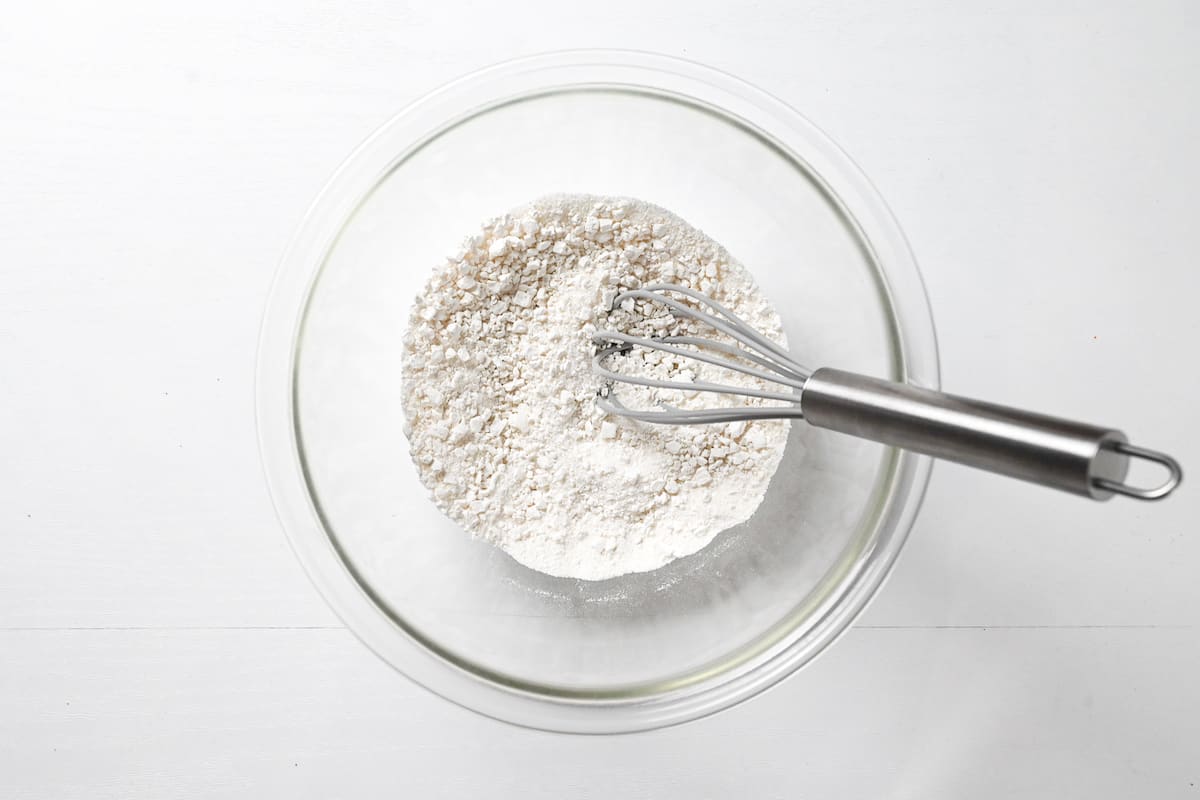
Next add the water all at once and whisk until smooth.
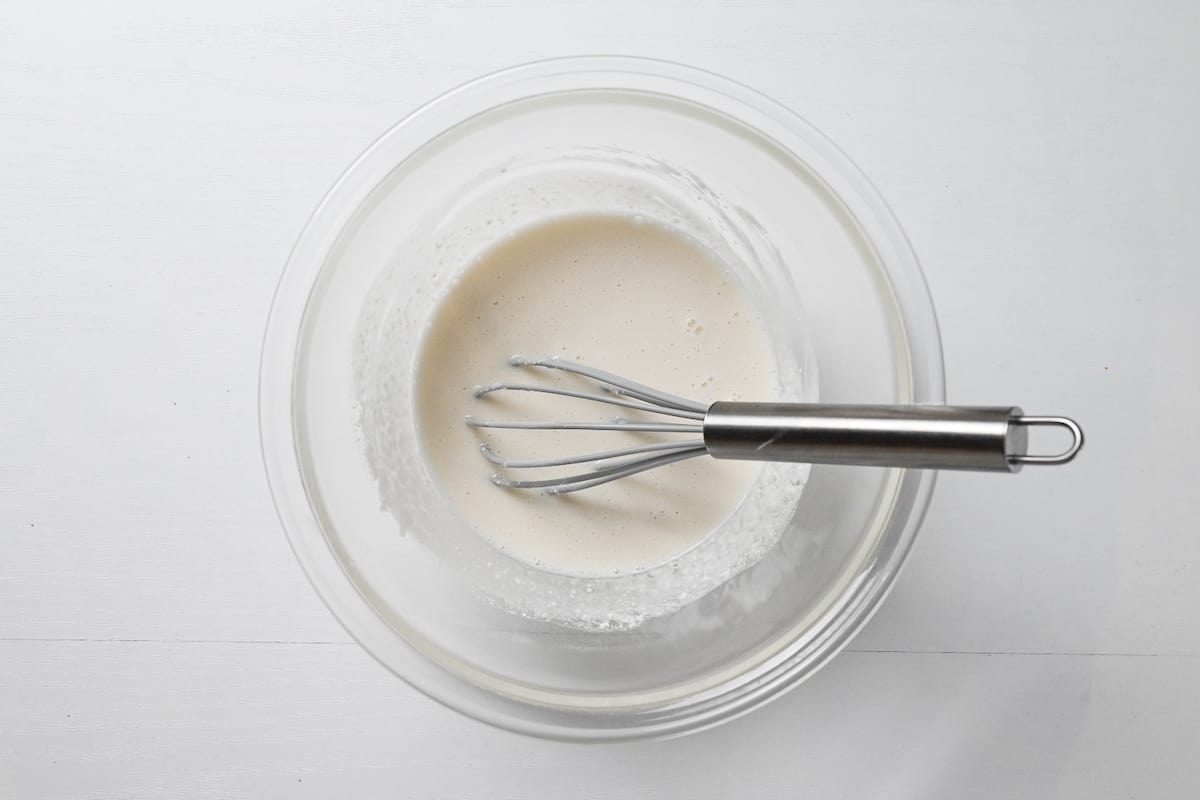
Cover the bowl tightly with plastic wrap and microwave for 1 minute 30 seconds at 600W. (Lower wattage will require longer.)
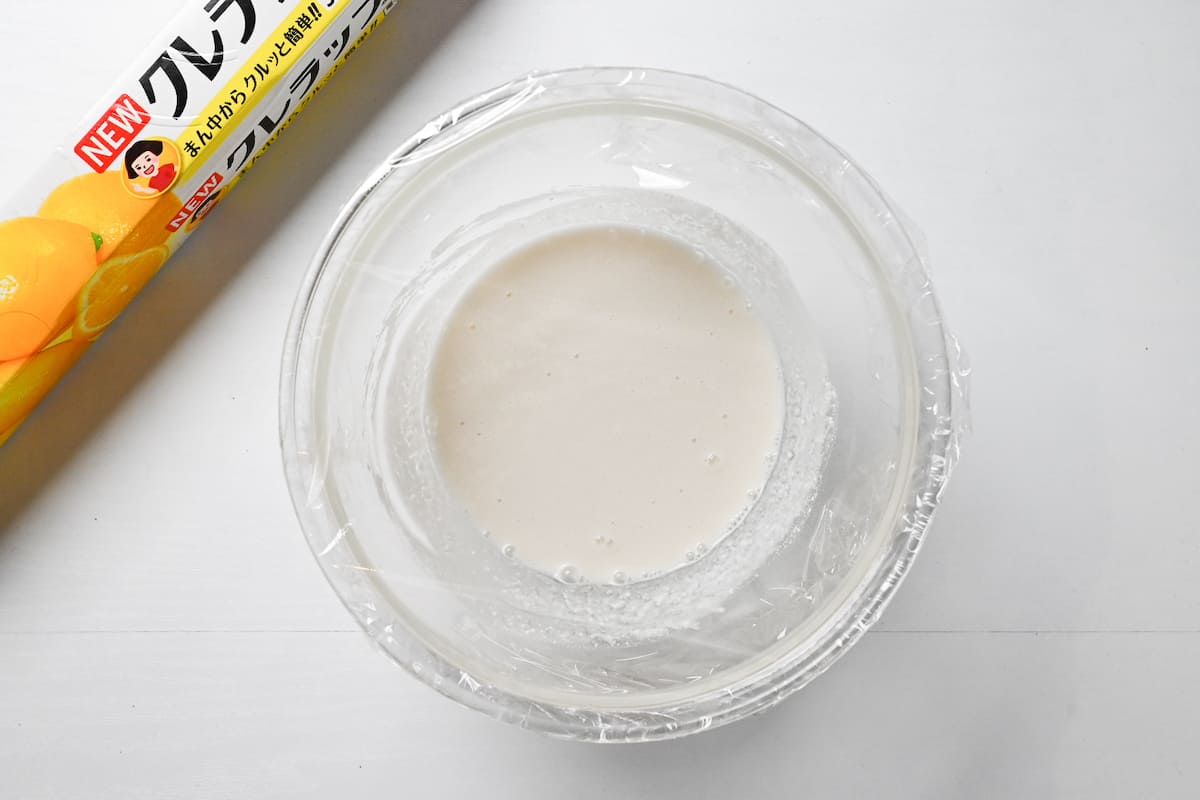
After the first blast in the microwave, the mixture will become lumpy. Switch to a spatula (preferably silicone) carefully peel back the plastic wrap, mix until the lumps are distributed through the mixture.
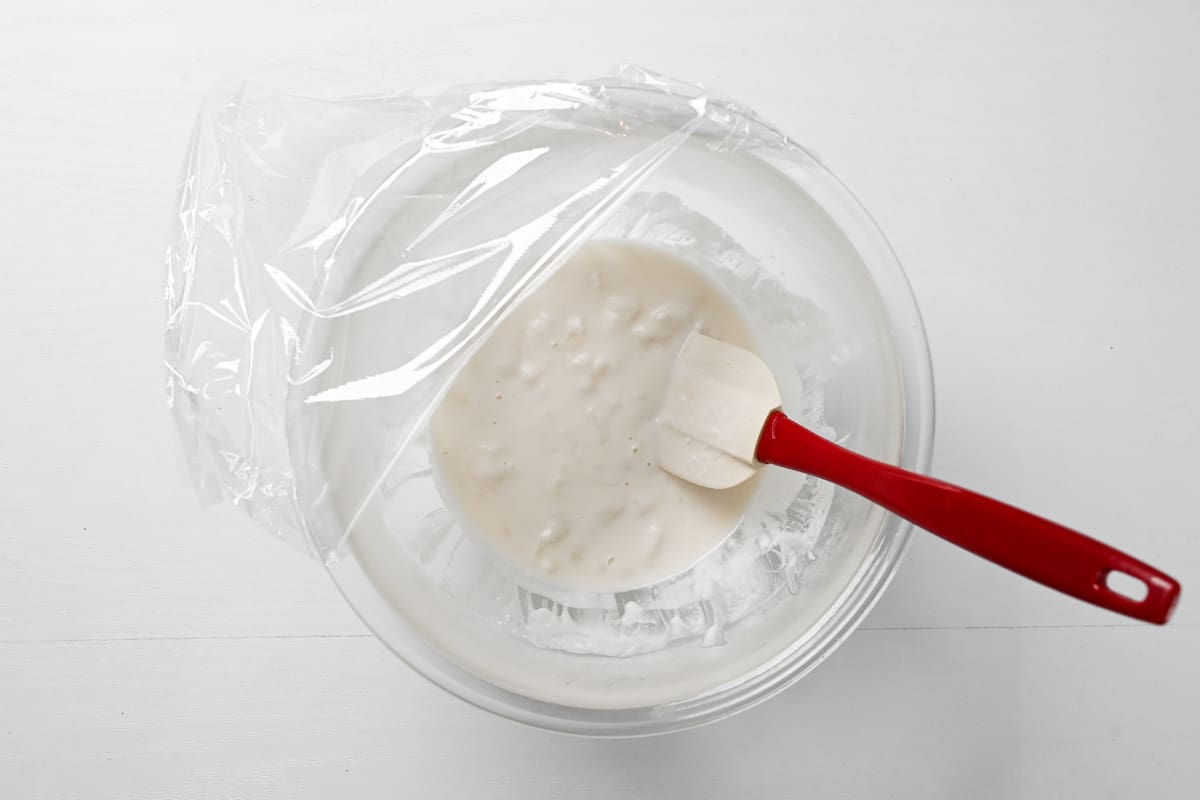
Cover with plastic wrap again and microwave once more for 2 minutes at 600W. When it comes out, mix the dough thoroughly until it becomes slightly translucent, it shouldn’t have any white parts left. Here is a close up of how it should look:
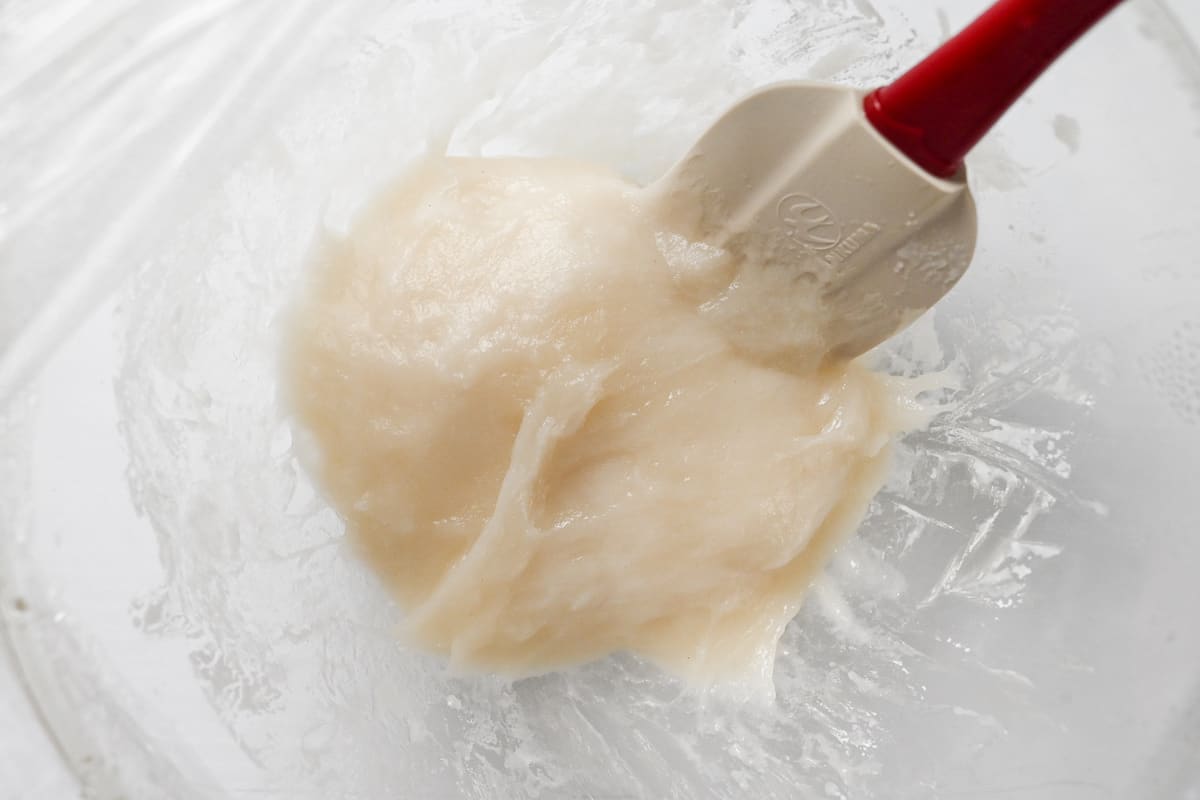
If you’re doubling or tripling the recipe, you might need to put it in the microwave again (if there is still white liquid in the bowl). I recommend microwaving for an extra minute and mixing each time until you achieve the consistency above.
The gyuhi is extremely sticky, so cover a surface with potato starch or corn starch. I like to use a tray to keep the mess contained for easy clean-up. If you plan to use a rolling pin to roll it out, it’s probably easier to coat a chopping board instead.
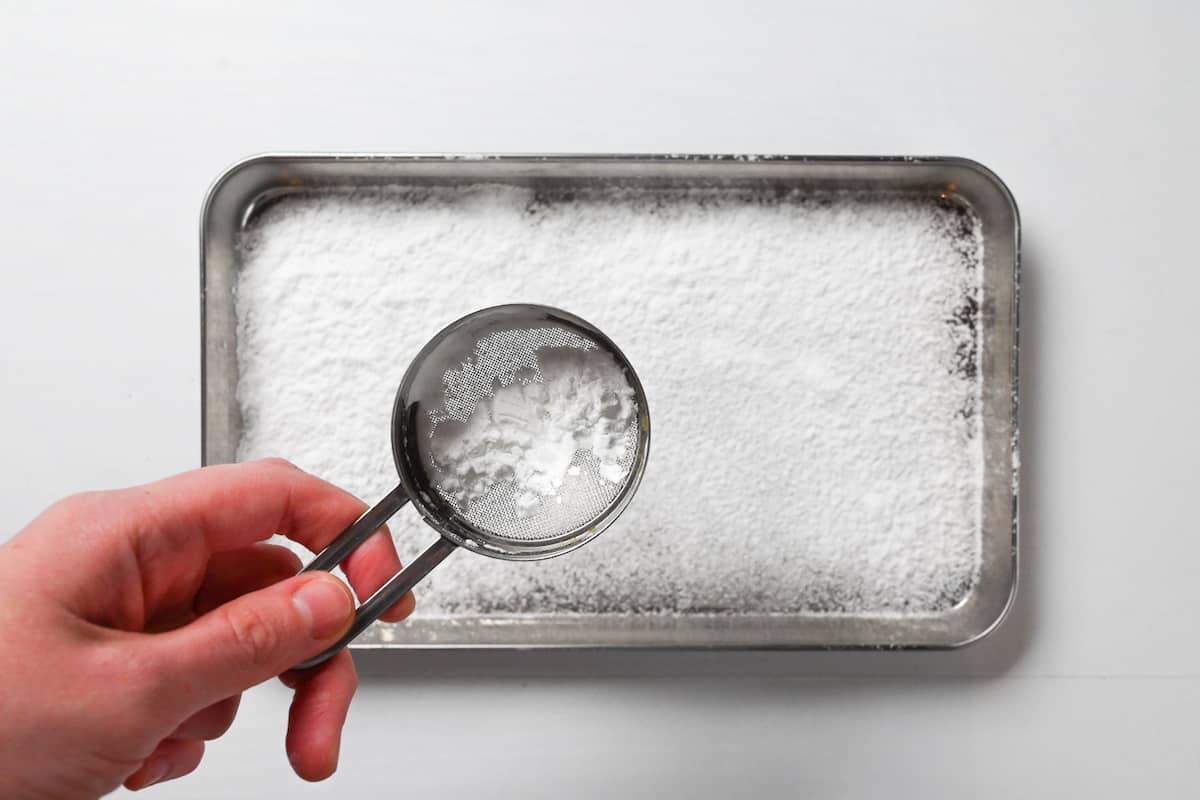
Use the spatula to scrape the mochi mixture onto the starch and then cover it generously with more starch.
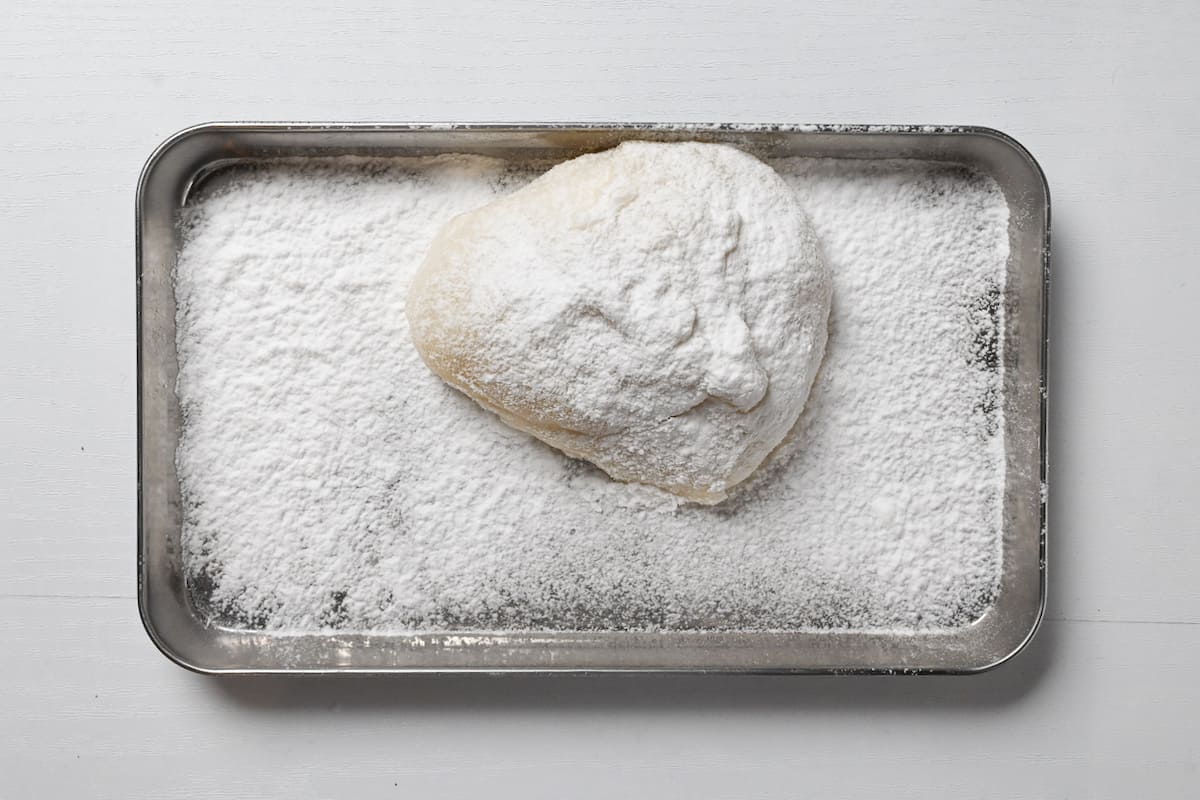
The mochi will still be hot, you can wait for it to cool down for 10 minutes or so.
I personally stretch the mochi out by hand while it’s still warm. Generously coat your hands with starch and stretch it out into a rectangle. Flip the dough over from time to time to stop it sticking to the tray and add more starch if sticky parts become exposed while stretching it out. In the end, it should be about 1cm thick. (If you’re using a rolling pin, make sure to coat it with starch and re-coat frequently.)
Once rolled out, cut into equal pieces.
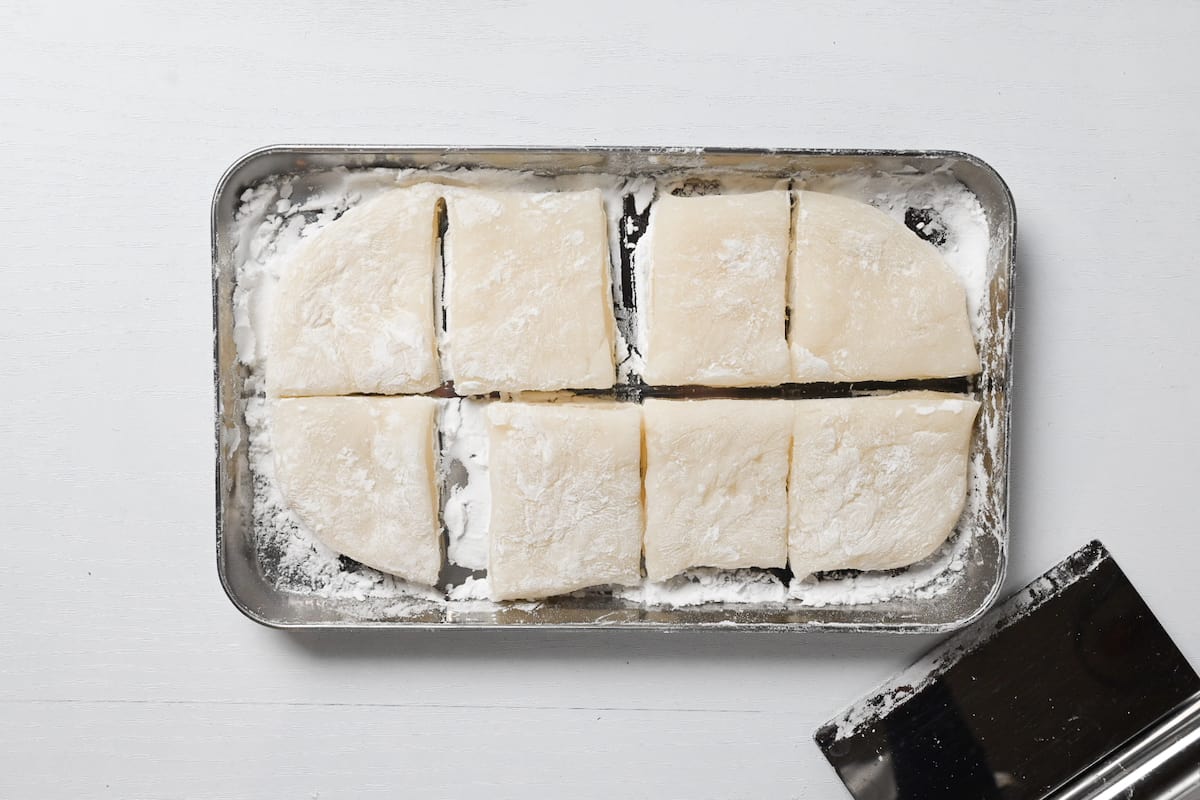
With starch-coated hands, take a square of mochi and place the anko-coated strawberry in the center with the point facing down. (This is why we left the point a little exposed earlier.)
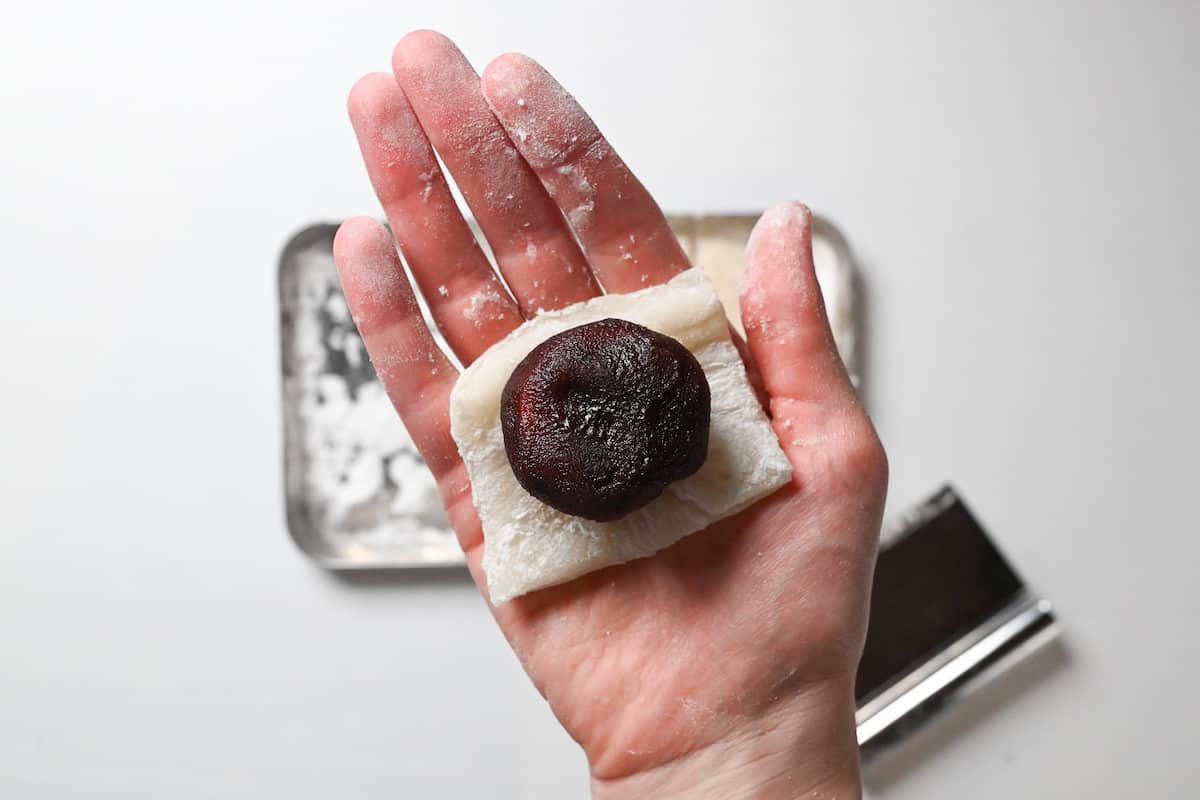
Pull the corners together over the base of the strawberry and pinch them to help them stick.
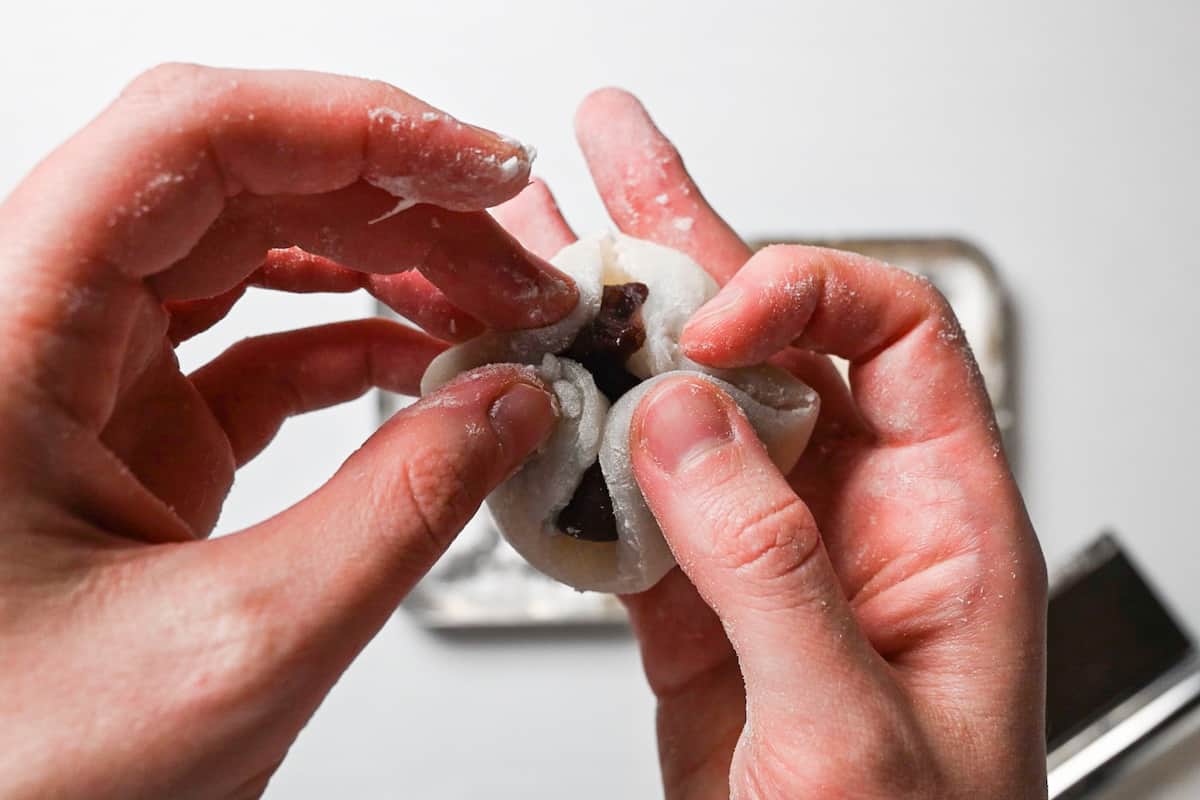
Pinch the edges together to close them up.
While shaping the mochi, the cut edges will be sticky. These are good for helping you seal up the mochi, but they tend to stick to your fingers. I always keep a bowl of potato starch nearby to sprinkle some extra whenever dough starts to stick to my hands.
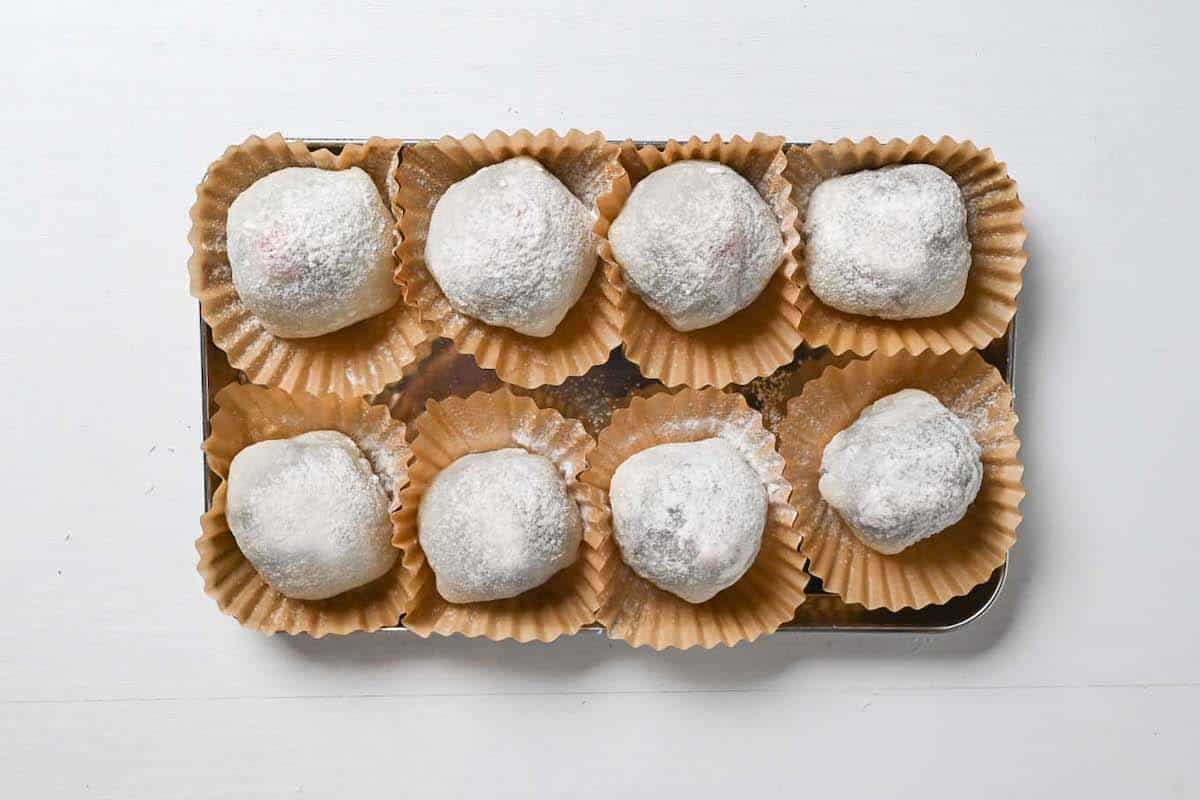
Gently roll the mochi in your palm to neaten up the circle shape.
Tip: Place them in cupcake cases to stop them from sticking to the tray or together!
Jump to Full Recipe MeasurementsHow to Store
Ichigo daifuku is best eaten the same day as the mochi will harden over time and the juices from the strawberry might start to leak out.
I would say the maximum time to keep them is 24 hours. Store them in an airtight container in the fridge to stop them from drying out (you can also individually wrap them in plastic wrap to protect them further).
Ichigo daifuku is not suitable for freezing.
In conclusion, keep refrigerated and eat within 24 hours.
Variations
Daifuku can be stuffed with many different fillings, the possibilities are pretty endless and you could be creative here! These are some kinds of fillings you can find in daifuku.
- Plain anko filling (adzuki red bean paste)
- Fruits – strawberries are the most popular but you can also use grapes, kiwis and clementines.
- Ice Cream
- Flavored Whipped Cream
- Chocolate ganache
FAQ
Here are answers to frequently asked questions I have received across all platforms, including here, YouTube, and Pinterest. If you have any questions, feel free to send them to me anytime! It will be a big help for everyone in this community!
Since mochi is made from rice flour, if it is exposed to air for a prolonged time it tends to dry out. This can also happen if it gets too cold, for example if you put it in the refrigerator. To keep the mochi soft, store it in an airtight container at room temperature and consume within 24 hours.
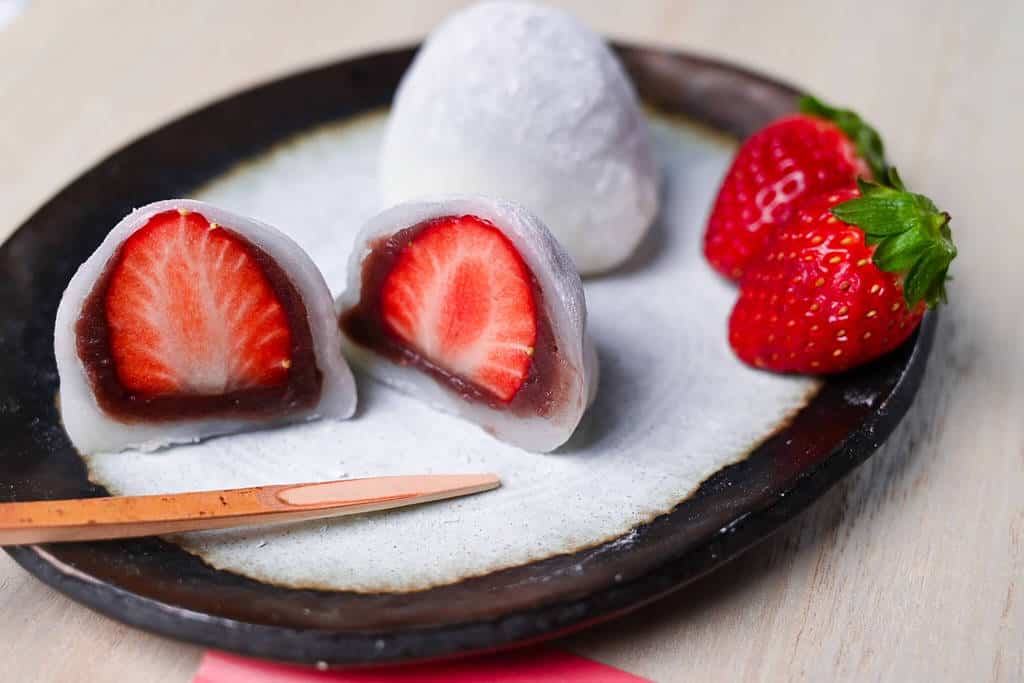
I hope you enjoy this Ichigo Daifuku recipe! If you try it out, I’d really appreciate it if you could spare a moment to let me know what you thought by giving a review and star rating in the comments below. It’s also helpful to share any adjustments you made to the recipe with our other readers. Thank you!
More Japanese-style Dessert Recipes
- Sata Andagi (Okinawan Donuts)
- Matcha Roll Cake (Green Tea Swiss Roll)
- Matcha Christmas Tree Butter Cookies
- Fudgy Dark Chocolate and Matcha Brownies
Want more inspiration? Explore my Japanese Dessert Roundup Post for a carefully selected collection of tasty recipe ideas to spark your next tea party!
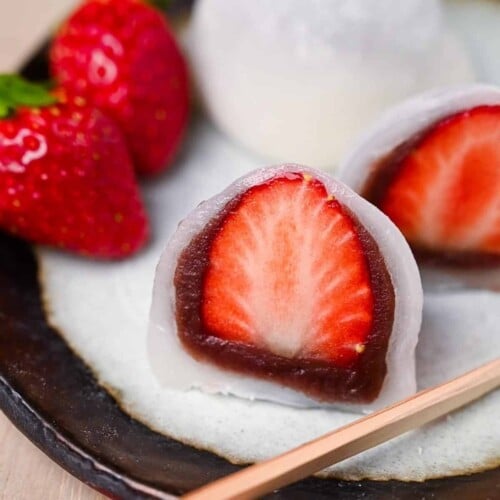
Easy Strawberry Mochi (Ichigo Daifuku)
Ingredients
- 160 g smooth red bean paste (koshian)
- 8 strawberries small or medium size
- 100 g glutinous rice flour shiratamako or mochiko
- 60 g white caster sugar
- 150 ml water
- cornstarch or potato starch for dusting
My recommended brands of ingredients and seasonings can be found in my Japanese pantry guide.
Can’t find certain Japanese ingredients? See my substitution guide here.
Instructions
- Roll 160 g smooth red bean paste (koshian) into 20g balls. Cover and and store in the refrigerator between steps.

- Wash 8 strawberries and dry them thoroughly. Cut off the stems and place them on a sheet of kitchen paper.

- Take the anko from the fridge and press each ball in the palm of your hand to make a flat circle and place a strawberry in the center.

- Pull the bean paste up around the edges of the strawberry, leaving the tip slightly exposed.

- Cover and store in the fridge until later.


- Pour 150 ml water into the bowl and mix until smooth.

- Cover with plastic wrap and microwave for 1 minute 30 seconds at 600W.

- Carefully peel back the plastic wrap. Use a spatula to scrape down the sides of the bowl and mix the cooked lumps into the rest of the mixture. Cover again and microwave for 2 minutes at 600W.

- Peel back the plastic wrap (be careful of steam) and mix vigorously with the spatula until the mochi looks translucent. (If there are still white bits, microwave in 20 second intervals.) The "gyuhi" (sweet mochi dough) is ready to shape.

- Coat a tray or chopping board with cornstarch and use the spatula to scrape the mochi out of the bowl and onto the starch. Allow it to cool for 5-10 minutes.

- Sprinkle starch over the top of the mochi and roll it to 1cm thick. You can use your hands to stretch it or a rolling pin to roll it, just make sure to dust your chosen tools generously with starch. Cut the dough into equal pieces.

- Coat your hand with starch and place one piece of mochi in the center of your palm and place an anko coated strawberry in the middle with the point facing down

- Pull the corners of the mochi over the base of the strawberry until they meet in the middle. Pinch them together until sealed. (Keep extra starch nearby in case it sticks to your fingers.

- Roll the finished mochi in your hand to neaten up the shape and place on a sheet of greaseproof paper/container sprinkled with starch. (You could also place them in cupcake cases)Tip: Wash your hands from time to time if they get sticky, then dry thoroughly before dusting with more potato starch.

- Enjoy!
Video
Notes
- Best stored in an airtight container in the refrigerator and consumed within 24 hours.
- If your mochi dough gets holes, pinch to close.
- Make sure to have a bowl of cornstarch or potato starch nearby just in case the mochi gets stuck to your hands or tools. Wash hands from time to time if they get too sticky.
- Try to use small/medium strawberries if you are making 8, larger strawberries will probably make only 4-6. (Consider this when cutting the “gyuhi” sweet mochi dough.)
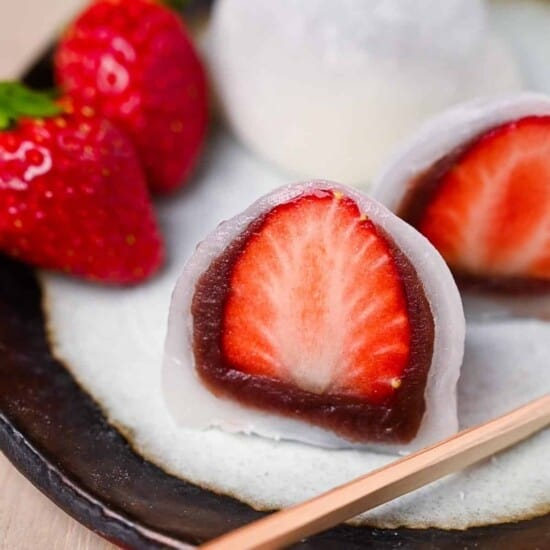



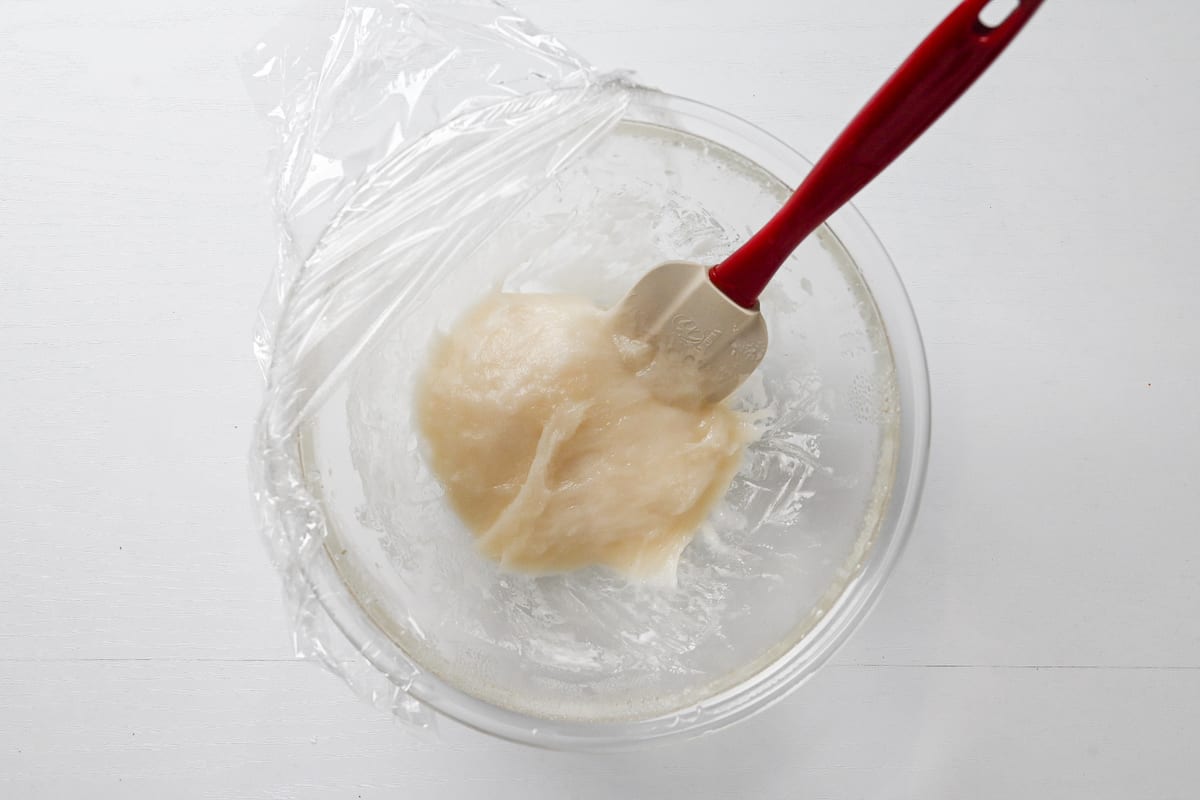
After cooling for 30 mins, it was crumbling and impossible to roll it
Are you talking about the red bean paste? If your anko is already easy to roll then you can skip that first step. I’ll edit the recipe to make that clearer. If it’s overcooked it can become dry and crumbly. You can try to save it by adding a little bit of water and honey/corn syrup gradually to try to add some moisture back in. Hope this helps.
Is there a work around for the mochi if you don’t have a microwave?
Hi Doug,
You can also steam it! I recommend using a cake pan or similar, line it with baking paper and pour the mochi mixture inside. Place it in a steaming basket over boiling water, cover with a lid and stir it twice in the first five minutes (be careful not to burn yourself on the steam). After 5 minutes, continue to steam for another 10-12 minutes and then continue the rest of the steps as stated in the recipe. Hope this helps!
Yuto
Well, I’m completely new to cooking in general, but I gave this a go – I made my own koshian (which I think was a little bit too loose…) But it turned out pretty tasty. I’ll make it again when I’m a bit more experienced. Thanks for the recipe!
Hi Craig,
Thank you so much for giving this recipe a go! Making koshian from scratch can be very tough, and even if it was a bit loose, I’m glad it turned out tasty. I’m really happy you enjoyed it! 🙂
Yuto
It’s simple yet delectable dessert, love it so much. I’ve been making this daifuku many times now, and each time it will be “vanished” swiftly. I use normal steamer and for the filling I swap the strawberry and anko with homemade chocolate truffle and custard. The whole family love it! Thank you very much for sharing this recipe!
Hi Elvira,
Thank you so much for your lovely comment — I’m really happy to hear you’ve made it many times! Great to know it works well with a regular steamer, and I love your twist with chocolate truffle and custard! 🙂
Yuto